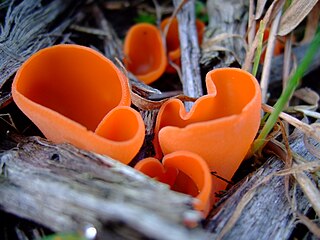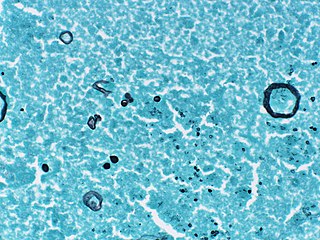Related Research Articles

Pezizomycotina make up most of the Ascomycota fungi and include most lichenized fungi too. Pezizomycotina contains the filamentous ascomycetes and is a subdivision of the Ascomycota. It is more or less synonymous with the older taxon Euascomycota. These fungi reproduce by fission rather than budding and this subdivision includes almost all the ascus fungi that have fruiting bodies visible to the naked eye.

Melaspileaceae is a family of lichenized, lichenicolous and saprobic fungi within Ascomycota. These fungi have long been poorly understood, and the family's taxonomic position has been unclear because of insufficient molecular data. It was previously included in the order Arthoniales but recent phylogenetic analyses indicate that it instead belongs to the order Eremithallales.
Pycnocarpon is a genus of fungi in the class Dothideomycetes and in the Asterinaceae family.
Rosenscheldia is a genus of fungi in the class Dothideomycetes. The relationship of this taxon to other taxa within the class is unknown.
Gloeodiscus is a genus of fungi in the class Dothideomycetes. The relationship of this taxon to other taxa within the class is unknown. Also, the placement of this genus within the Dothideomycetes is uncertain. A monotypic genus, it contains the single species Gloeodiscus nigrorufus.
Coccochorina is a genus of fungi in the class Dothideomycetes. The relationship of this taxon to other taxa within the class is unknown. Also, the placement of this genus within the Dothideomycetes is uncertain.
The Pseudoperisporiaceae are a family of fungi with an uncertain taxonomic placement in the class Dothideomycetes.
The Microthyriaceae are a family of fungi with an uncertain taxonomic placement in the class Dothideomycetes.
The Microtheliopsidaceae are a family of fungi with an uncertain taxonomic placement in the class Dothideomycetes. A monotypic taxon, it contains the single genus Microtheliopsis.
The Parmulariaceae are a family of fungi with an uncertain taxonomic placement in the class Dothideomycetes.
The Micropeltidaceae are a family of fungi with an uncertain taxonomic placement in the class Dothideomycetes.
The Aulographaceae are a family of fungi with an uncertain taxonomic placement in the class Dothideomycetes.

The Coccoideaceae are a family of fungi with an uncertain taxonomic placement in the class Dothideomycetes.
The Cookellaceae are a family of fungi with an uncertain taxonomic placement in the class Dothideomycetes.
The Eremomycetaceae are a family of fungi with an uncertain taxonomic placement in the class Dothideomycetes.
The Hypsostromataceae are a family of fungi with an uncertain taxonomic placement in the class Dothideomycetes.
The Mesnieraceae are a family of fungi with an uncertain taxonomic placement in the class Dothideomycetes.
The Aliquandostipitaceae are a family of fungi in the Ascomycota, class Dothideomycetes. The family was described by Patrik Inderbitzin in 2001, and the order Jahnulales was created in 2002 to accommodate the family. The distinguishing characteristic for members of the family are the unusually wide hyphae that support the spore-bearing structures, and the presence of ascomata both with and without stalks. The genus Aliquandostipe has a pantropical distribution, having been found in Central America and southeast Asia; Jahnula has a wider distribution. Species in the family are saprobic, and are typically found growing on rotting wood.
The Antennulariellaceae are a family of fungi in the Ascomycota, class Dothideomycetes. The family was named by Nikolai Nikolaevich Woronichin in 1925 to contain the genus Antennulariella that he had described a decade earlier in 1915. Species in the family have a widespread distribution, and are found in warm temperate to tropical locations, where they grow as black sooty molds on plants.

The Capnodiaceae are a family of fungi in the Ascomycota, class Dothideomycetes. Species in the family have a widespread distribution, and are especially prevalent in tropical and subtropical areas, as well as temperate rainforests.
References
- ↑ Lumbsch TH, Huhndorf SM (December 2007). "Outline of Ascomycota – 2007". Myconet. Chicago, USA: The Field Museum, Department of Botany. 13: 1–58.
- ↑ Cannon PF, Kirk PM (2007). Fungal Families of the World. Wallingford, UK: CAB International. p. 233. ISBN 0-85199-827-5.
- ↑ Lumbsch HT, Lindemuth R (2001). "Major lineages of Dothideomycetes (Ascomycota) inferred from SSU and LSU rDNA sequences". Mycological Research. 105 (8): 901–908. doi:10.1016/S0953-7562(08)61945-0.